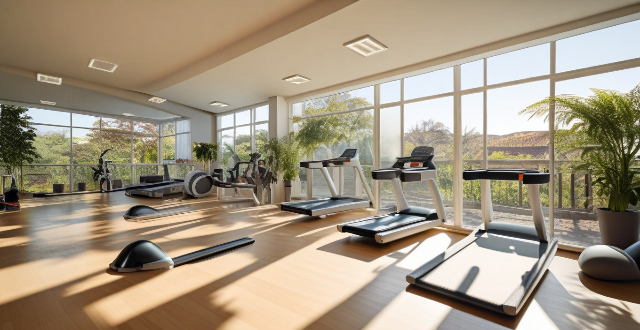Rate Fitness

How accurate are fitness trackers in monitoring heart rate ?
The accuracy of fitness trackers in monitoring heart rate can be affected by various factors, including device quality, skin type and color, movement, and environmental factors. To improve the accuracy of your fitness tracker's heart rate monitor, it is recommended to choose a reputable brand with advanced sensors and algorithms, wear your device correctly, calibrate your device, and use multiple sensors or a chest strap for better results. By following these tips, you can make more informed decisions about your health and fitness goals.

How often should I check my heart rate while exercising ?
Checking your heart rate is an important part of staying healthy and fit. However, how often you should check it depends on several factors, including your age, fitness level, and overall health. Here are some guidelines to help you determine the optimal frequency for checking your heart rate during exercise: For beginners: Check your heart rate every five minutes during the first few weeks of training to get a sense of your target heart rate range and adjust accordingly as you become more comfortable with the activity. For experienced athletes: Once or twice per workout is sufficient for experienced athletes who have established a good foundation in their fitness routine. This will allow them to focus more on their form and intensity without constantly worrying about their heart rate. For older adults or those with pre-existing health conditions: Older adults or those with pre-existing health conditions may need to monitor their heart rate more frequently than younger individuals. It's recommended that they check their heart rate at least once per workout and perhaps even before and after each session to stay safe and ensure they're not overexerting themselves.

How does age affect heart rate during exercise ?
Age affects heart rate during exercise by altering the structure and function of the aging heart, reducing maximum heart rate, shifting autonomic regulation towards sympathetic dominance, and decreasing cardiac reserve. Older individuals can still improve their cardiovascular fitness through regular exercise and lifestyle modifications.

Are fitness trackers worth the investment ?
Fitness trackers can provide motivation, data collection, convenience, community support, and customization. However, they also come with potential drawbacks such as cost, inaccuracy, dependency, overemphasis on quantification, and battery life issues. The decision to invest in a fitness tracker should be based on individual needs and priorities.

Can heart rate monitoring help prevent overexertion during exercise ?
Overexertion during exercise can lead to fatigue, muscle soreness, and injuries. Heart rate monitoring is a technique used to measure the number of times a person's heart beats per minute (bpm). By monitoring your heart rate, you can determine personalized training zones based on age, fitness level, and goals, providing real-time feedback on current heart rate during exercise. Recovery time is essential for preventing overexertion, and heart rate monitoring helps determine how long it takes for the body to return to its resting state. Best practices for heart rate monitoring include choosing the right device, calibrating regularly, warming up properly, staying hydrated, and listening to your body. Following these guidelines and listening to your body can help prevent overexertion during exercise while maximizing its benefits.

How can I use heart rate monitoring to improve my workout routine ?
Using a heart rate monitor can significantly improve your workout routine by providing valuable insights into your body's response to exercise. Here's how you can leverage heart rate monitoring to optimize your fitness regimen: - Understanding Heart Rate Zones: Your heart rate varies depending on the intensity of your workout. By understanding these heart rate zones, you can tailor your workouts to achieve specific goals, such as fat burning, endurance building, or performance improvement. - Setting Goals Based on Heart Rate: Establish clear objectives for each workout session based on your heart rate data, such as endurance training, weight loss, or performance enhancement. - Tracking Progress: Consistently monitor your heart rate during workouts to track progress, including recording resting heart rate and assessing recovery time. - Adjusting Intensity: Modify your workout intensity based on your heart rate feedback, such as increasing intensity if you're consistently below your target heart rate zone or decreasing intensity if you're above it. - Preventing Overtraining: Use heart rate data to avoid overtraining by staying within recommended heart rate limits and recognizing signs of overexertion. - Personalizing Your Workouts: Customize your routine with heart rate in mind by incorporating different training methods and experimenting with different activities to see which ones give you the desired heart rate response.

How do fitness trackers measure calories burned ?
**How Fitness Trackers Measure Calories Burned: A Comprehensive Overview** Fitness trackers have revolutionized the way we monitor our physical activities and health. One of their most popular features is the ability to estimate the number of calories burned during various exercises. But how do these devices actually calculate this information? In this article, we delve into the science behind fitness trackers and explore the key components that contribute to their calorie-burning estimates. Firstly, heart rate monitoring plays a crucial role. By tracking your heart rate, fitness trackers can gauge the intensity of your workout and, therefore, the approximate number of calories you're burning. Secondly, activity recognition allows the device to identify specific types of movement, such as walking or running, and apply corresponding metabolic equivalent (MET) values to calculate energy expenditure. Thirdly, personal information like age, gender, height, weight, and daily activity level are essential for customizing calorie burn calculations to your unique profile. Finally, sophisticated algorithms combine all these data points to provide an estimate of calories burned. However, it's important to remember that these estimates are not exact measurements but rather approximations based on scientific research and technological advancements. As such, fitness trackers should be viewed as valuable tools to aid in your fitness journey rather than definitive indicators of progress.

What is the best way to monitor heart rate during exercise ?
Monitoring heart rate during exercise is crucial for staying healthy and achieving fitness goals. The best way to monitor heart rate during exercise depends on personal preferences and fitness goals. Wearable heart rate monitors are convenient and non-invasive, while chest straps provide accurate data. Fingertip devices are affordable and easy to use, but less accurate than other methods. Smartphone apps are free or inexpensive, but may not work well in certain situations. Ultimately, the choice between these methods should be based on individual needs and preferences.

What are the best fitness trackers on the market ?
The article provides a summary of the best fitness trackers on the market, including Garmin Vivosmart 4, Fitbit Charge 3, Samsung Galaxy Fit, Apple Watch Series 6, and Xiaomi Mi Band 5. Each tracker offers accurate tracking of daily activities, heart rate monitoring, and smartphone notifications. The Apple Watch Series 6 also includes ECG readings and blood oxygen levels, while the Fitbit Charge 3 has a swimproof design and the Samsung Galaxy Fit offers customizable watch faces. Ultimately, the choice of fitness tracker depends on budget, fitness goals, and personal preferences.

Which fitness tracker has the longest battery life ?
When it comes to choosing a fitness tracker, battery life is an important factor to consider. A longer battery life means less frequent charging and more time spent focusing on your fitness goals. In this article, we will explore which fitness tracker has the longest battery life. The Garmin Fenix 6 Pro is a popular choice for outdoor enthusiasts and athletes. It boasts an impressive battery life of up to 14 days, depending on usage. This makes it a great option for those who spend long periods of time away from home or on extended trips. The Fitbit Charge 4 is a versatile fitness tracker that offers a range of features, including built-in GPS, heart rate monitoring, and sleep tracking. Its battery life is also quite impressive, with up to 7 days of use on a single charge. The Amazfit GTR 2 is another fitness tracker that offers a long battery life, with up to 14 days of use on a single charge. It also features a sleek design and a range of health and fitness tracking options. The Xiaomi Mi Band 6 is a budget-friendly fitness tracker that still offers a respectable battery life of up to 13 days. It includes features such as heart rate monitoring, sleep tracking, and stress monitoring. While all of these fitness trackers offer impressive battery life, our top pick for the longest battery life is the Garmin Fenix 6 Pro. With its rugged design and advanced sports metrics, it is ideal for outdoor enthusiasts and athletes who require a reliable and durable fitness tracker that can keep up with their active lifestyles.

How can I monitor my heart rate during exercise for optimal health results ?
Monitoring your heart rate during exercise is crucial for efficiency, safety, and progress tracking. Tools include heart rate monitors, smartphone apps, fitness trackers, and chest straps. Before starting, consult a doctor and choose the right tool. During exercise, wear your monitor, warm up, stay in your target heart rate zone, adjust intensity, and cool down. After exercise, record data, analyze results, and rest. Best practices include calibrating devices, staying hydrated, being consistent, and listening to your body.

How do wearable devices and fitness trackers influence athletic performance ?
Wearable devices and fitness trackers have become increasingly popular among athletes and fitness enthusiasts. These devices monitor various aspects of physical activity, such as heart rate, steps taken, calories burned, and sleep patterns. By providing real-time feedback on these metrics, wearable devices and fitness trackers can significantly influence athletic performance through goal setting, training optimization, injury prevention, and data-driven decision making. As technology advances, these devices will likely become even more integral to an athlete's training routine.

What is the ideal heart rate for different types of exercises ?
When it comes to exercise, knowing your ideal heartWhen it comes to exercise, knowing your ideal heartimizing the benefits of your knowing your ideal heart rate is crucial for maximizing the benefits of your workout while minimizing the risk of injury. The recommended heart rate ranges vary depending on the type of exercise and your fitness level. For aerobic exercise, beginners should aim for 50-60% of their maximum heart rate (MHR), intermediate exercisers 60-70% of MHR, and advanced exercisers 70-85% of MHR. High-intensity interval training (HIIT) requires higher intensity, with beginners aiming for 70-80% of MHR, intermediate exercisers 80-90% of MHR, and advanced exercisers 90-100% of MHR. Resistance training also varies by fitness level, with beginners aiming for 50-60% of MHR, intermediate exercisers 60-70% of MHR, and advanced exercisers 70-85% of MHR. Yoga and Pilates are low-impact exercises that focus on flexibility, balance, and core strength, with beginners aiming for 40-50% of MHR, intermediate exercisers 50-60% of MHR, and advanced exercisers 60-70% of MHR. By monitoring your heart rate and staying within the recommended ranges, you can ensure that you're exercising safely and effectively.

What are the benefits of monitoring heart rate during exercise ?
Monitoring your heart rate during exercise offers numerous benefits, including improved workout efficiency, better recovery, reduced risk of injury, increased motivation, and improved cardiovascular health. By keeping an eye on your heart rate, you can ensure you're getting the most out of every workout while also taking care of your body.

How do I choose the right fitness tracker for my needs ?
When selecting a fitness tracker, consider your goalsWhen selecting a fitness tracker, consider your goals, device compatibility, consider your goals, budget, tracking features, device compatibility, design, and reviews. Test the tracker before buying if possible to ensure it meets your needs and helps you achieve your fitness goals.

In what ways can heart rate monitors improve athletic training ?
Heart rate monitors significantly enhance athletic training by enabling targeted intensity, objective data analysis, recovery monitoring, pacing strategies, and individualized training. To use them effectively, athletes should establish baseline measurements, set clear goals, create a structured plan, continuously monitor progress, and incorporate technology for easy tracking and insights.

Are there any risks associated with constantly monitoring heart rate during exercise ?
Monitoring heart rate during exercise is common but can pose risks like over-reliance on technology, psychological impacts, and physical risks. It's important to find a balance between using heart rate data and listening to your body's signals for a safe and enjoyable workout.

Can strength training be part of a female fitness program ?
**Can Strength Training Be Part of a Female Fitness Program?** Yes, strength training is crucial for women's fitness programs. It offers benefits such as improved muscle tone, increased metabolism, enhanced bone density, and reduced injury risk. To integrate strength training effectively: start with light weights, focus on compound movements, balance it with cardio workouts, and consider professional guidance for personalized plans. This approach ensures a comprehensive and beneficial fitness regimen for women.

What are the best iPhone apps for fitness and health tracking ?
Staying fit and healthy is essential for a happy life, and with the advancement of technology, there are numerous apps available on the iPhone that can help you track your fitness and health goals. Here are some of the best iPhone apps for fitness and health tracking: 1. MyFitnessPal - A popular calorie counter and diet tracker app that allows you to log your daily food intake and exercise routine. It has a massive database of foods, making it easy to find and track what you're eating. The app also integrates with other fitness apps, such as Apple Health, to provide a comprehensive view of your overall health and fitness. 2. Fitbit - A wearable device that tracks your daily activity, including steps taken, distance traveled, calories burned, and sleep quality. The accompanying iPhone app allows you to view your data in real-time and set personalized goals based on your fitness level. You can also join challenges with friends and compete against each other to stay motivated. 3. Strava - An excellent app for runners and cyclists who want to track their workouts and compare their performance with others. The app uses GPS to map your runs or rides, providing detailed metrics such as pace, speed, elevation gain, and heart rate. You can also join clubs and participate in virtual races to stay motivated. 4. Nike Training Club - Offers a wide range of workout routines designed by professional trainers to help you achieve your fitness goals. The app includes videos demonstrating each exercise, along with tips on proper form and technique. You can also track your progress over time and set personalized goals based on your fitness level. 5. Headspace - While not strictly a fitness app, Headspace is an excellent tool for managing stress and improving mental well-being, which are crucial components of overall health. The app offers guided meditation sessions suitable for beginners and experienced practitioners alike, helping you relax and refocus throughout the day.

What are some common mistakes people make when monitoring their heart rate during exercise ?
When monitoring heart rate during exercise, common mistakes include incorrect sensor placement, over-reliance on technology, misinterpreting data, not tracking recovery time, and ignoring other factors. It's important to wear the sensor correctly, understand technology limitations, consider individual differences, track recovery time, and take environmental and medication factors into account for accurate readings.

How do I calculate the conversion rate for different currencies ?
Calculating conversion rates for different currencies involves determining the current exchange rate, calculating the conversion rate, considering any fees or commissions, and using a conversion tool if needed. By following these steps, you can ensure that you are getting an accurate estimate of the amount of currency you will receive after the conversion.

How does exercise physiology explain the differences in fitness levels among individuals with different genetic backgrounds ?
Exercise physiology explores the interaction between genetic factors and environmental influences like exercise, nutrition, and sleep to explain variations in fitness levels among individuals. It examines how muscle fiber composition, cardiovascular efficiency, metabolic rate, and body composition affect one's ability to perform physical activities. While genetic background sets a baseline for fitness potential, lifestyle choices significantly impact an individual's actual fitness outcomes. By understanding these principles, individuals can optimize their fitness through targeted exercise training, proper nutrition, and adequate rest.

What is the difference between a fixed-rate and adjustable-rate mortgage ?
The text discusses the differences between a fixed-rate and adjustable-rate mortgage. A fixed-rate mortgage has a constant interest rate throughout the loan term, offering stability and predictability in monthly payments. An adjustable-rate mortgage (ARM) has a fluctuating interest rate based on market conditions, with potential savings if rates decrease but also the risk of higher payments if rates increase. The choice between the two depends on personal financial situation, risk tolerance, and long-term goals.

Do fitness trackers accurately monitor sleep patterns ?
The article discusses the accuracy of fitness trackers in monitoring sleep patterns. It explains that while these devices can provide useful information about sleep duration, quality, and stages, their accuracy may vary depending on factors such as device placement, user movement during sleep, and environmental conditions. The article also compares fitness trackers to professional sleep studies conducted by medical professionals and concludes that fitness trackers should not be considered a substitute for these studies.

How long does it take to see improvements in cardiorespiratory fitness from starting an exercise routine ?
When starting an exercise routine to improve cardiorespiratory fitness, noticeable changes can occur within weeks, but significant and lasting improvements typically take several months of consistent training. Factors affecting improvement rates include baseline fitness level, workout frequency and intensity, age, health status, nutrition, recovery, and genetics. To maximize progress, set realistic goals, mix up your routine, monitor your progress, stay consistent, and get adequate rest.

What certifications should I get as a fitness instructor ?
To become a certified fitness instructor, it's crucial to obtain essential certifications like CPR/AED, personal training, group fitness instruction, and specialty areas of interest. Participating in continuing education will help you stay current and relevant in your field.

What are the fitness secrets of celebrity athletes ?
Celebrity athletes maintain their exceptional physical abilities and impressive performances in their respective sports through various fitness strategies, including consistency and discipline, high-intensity training, strength training, proper nutrition, and adequate recovery time. These principles can be applied by anyone looking to improve their fitness level and achieve their goals.

What features should be included in a comprehensive sports and fitness app ?
A comprehensive sports and fitness app should provide a broad range of features to cater to the diverse needs of its users, including goal tracking, workout planning, nutrition tracking, social interaction, personalized coaching, and health monitoring. These features are designed to help users achieve their fitness goals, track progress, and stay motivated throughout their journey.

What are some popular health management apps among athletes and fitness enthusiasts ?
Staying fit and healthy is a top priority for many people, especially athletes and fitness enthusiasts. With the advancement of technology, there are now numerous health management apps available that can help individuals track their progress, set goals, and stay motivated. Some popular options include MyFitnessPal, which is a calorie tracking app that allows users to log their daily food intake and exercise; Strava, a social networking app for athletes that tracks running and cycling activities using GPS; Fitbit, a wearable device that tracks various aspects of the user's health; and Nike Run Club, a running app designed to help users improve their running performance. By utilizing these tools, individuals can effectively track their progress, set goals, and stay motivated on their fitness journey.

Which extreme sport has the highest mortality rate ?
This article explores which extreme sport has the highest mortality rate. It discusses five extreme sports: parachuting, base jumping, free solo climbing, big wave surfing, and skydiving. Based on available data, base jumping appears to have the highest mortality rate among extreme sports, followed closely by free solo climbing. However, it is important to note that participating in any extreme sport requires proper training, equipment, and supervision to minimize the risks involved.